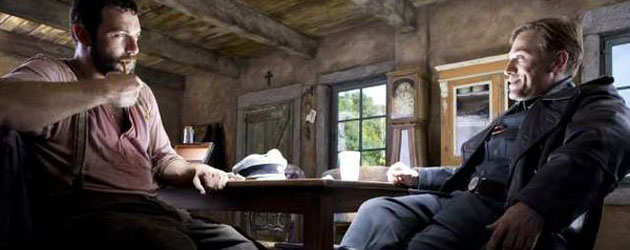David Wasco & Sandy Reynolds-Wasco

So there were a couple curveballs but curveballs come in pretty much every movie. That’s one of the things that we really like about what we do. Every movie is completely different. You have a blueprint -you do this first and you do that second. You try to get as much ready before principal photography because when principal photography starts it’s like a starter pistol goes off. And then it goes from high gear to overdrive and you’re working 24 hours a day and it’s basically chaos.
SRW: Controlled chaos.
AS: Are you on the set during shooting?
DW: Sandy more than me. I deliver the set and walk the director around and have him say, This is fine, or I’d like to change this, or I’d like to do that. I like to open the set every day and make sure all the elements are there for that day of shooting. At the same time as we’re shooting, we’re prepping the next set and striking the set from before. I usually don’t like to hang around because the environment on a shooting set is a slowed-down pace, like an ocean-liner. It’s based around the actors and assistant director and what the director’s trying to do with the actors. I make sure that there is a good onset dresser but I don’t like to be just standing around with my hands in my pockets.
SRW: I usually stay on every set until the DP has shot all four walls because the minute David has walked through the set with the director and they walk away, everything disappears. The furniture is pulled out so that the lighting can come in, and the camera. I try to document the set as it was when the director first walks in. So I’ll have a record to hand the onset dresser who is so key to our department, a sort of an unsung hero for us. But there are always changes so until the thing gets really locked down I like to be there to help compose the shots. Before I decorated I did the gamut of other jobs and one of them was an onset. So I know immediately the kind of things to listen for and to prepare for before they have to ask for it. It’s good to just watch the crew and see how much care they’re taking. Once it’s all locked down then I feel comfortable leaving. Because you know if it’s not right and you’re three hours away at some other location they’re going to call you!
AS: You mentioned that one of your early films was Night of the Comet. John Myhre and John Muto both also worked on that.
DW: That’s the only movie that I ever took set decorator credit on. When you’re starting out any morsel of a job is a great opportunity. Again it was the director Thom Eberhardt who wrote the material. It was John Myhre’s first job- he was assistant props on the movie. I remember the two of us driving around in a step van together picking up furniture and props. John Muto was the art director -it was before they started liberally using production designer as credit. It was the only zombie movie that I have worked on and it’s actually a great zombie movie! It’s a wonderful and interesting movie in L.A., shot all here.
Thank you for publishing such a great, in-depth interview with The Wasco’s! – it really captures how wonderful and talented they are, and their love and respect for cinema and architecture. And I really enjoy your blog in general – what a cool resource of ongoing conversations! Keep it up!
Robert Foulkes/Location Manager
I agree with Robert. I’ve read every single one of your interviews and everyone offers such great advice. Inglorious Bastards was such a great film and to hear their story makes it even better. I’m on the distribution and sales side of the business, but my passion has always been designing and art, so to read these stories is truly inspiring.
Thank you!!!